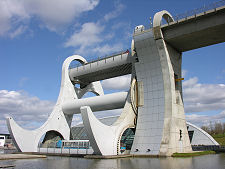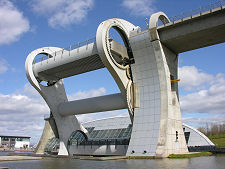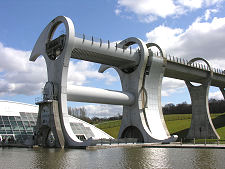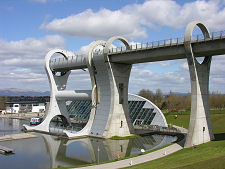The solution is the Falkirk Wheel. Boats approaching from the higher Union Canal now use a new length of waterway before descending through two locks. They then progress through a new 168m long tunnel that emerges at the start of a 104m concrete aqueduct. The far end of this opens directly into the upper of the two "gondolas" of the Falkirk Wheel.
The wheel then rotates, and having descended, what is now the lower gondola opens out into a 100m circular basin whose landscaping carefully conceals its origins as an open cast pit. On one side of this is the beautifully curved structure of the visitor centre. One final lock at the far end of the basin lowers boats to the level of the Forth and Clyde Canal.
Most visitors make their way to the Falkirk Wheel by road rather than by canal. It is well signposted from every approach to the Falkirk area. Entrance to the visitor centre is free, and inside you will find a range of background material on the Millennium Link and on the Falkirk Wheel itself. You will also find a large shop and a cafe selling a range of good value food.
But it is the Falkirk Wheel itself that draws visitors to this spot. It is 35m or 115ft high, the height of eight double-decker buses. Each gondola contains 300 tonnes of water, meaning that the wheel moves 600 tonnes on each lift. But because the gondolas are always in balance (because boats displace their own weight of water) moving them takes surprisingly little power. Up to eight boats can be carried at any one time.
And while many visitors will be happy simply admiring a remarkable structure designed both to look good and function well, the real experience only comes from trying it out for yourself. Details of boat trips are set out on the right. You board your hour long trip in front of the Visitor Centre before being lifted in the wheel to the length of canal through Roughcastle Tunnel. Beyond the tunnel your boat turns, before returning through it and descending via the wheel. Advance booking of boat trips is highly recommended.
And if one wonder of its age is not enough for you, footpaths from the Falkirk Wheel take you a little over half a mile to Rough Castle Roman Fort, complete with one of the best preserved stretches of the Antonine Wall.
In the pre-railway era the Central Belt of Scotland had two main canals. The Forth and Clyde Canal opened in 1790 and allowed ships to sail the 35 miles between the Clyde at Glasgow to the Forth at Grangemouth. En route they negotiated 40 locks and 32 swing bridges.
 The Wheel Seen Across Lower Basin | |
 The Rotation Starting | |
 Rotation Nearing Completion | |
 Closeup of Upper Gondola | |
 The Wheel from the North West | |
 Approaching the Top of the Wheel | |
 The Wheel from the South West |



















